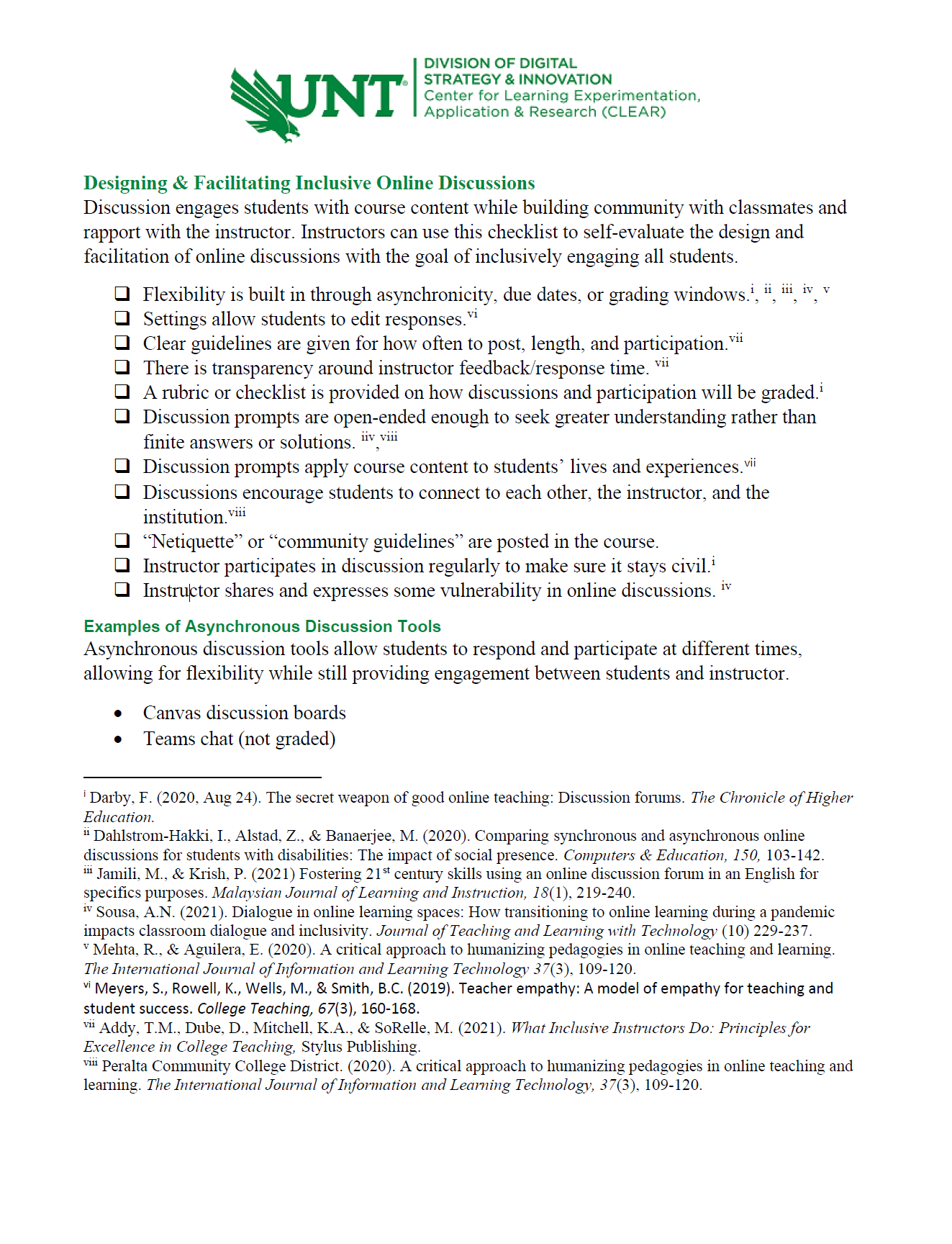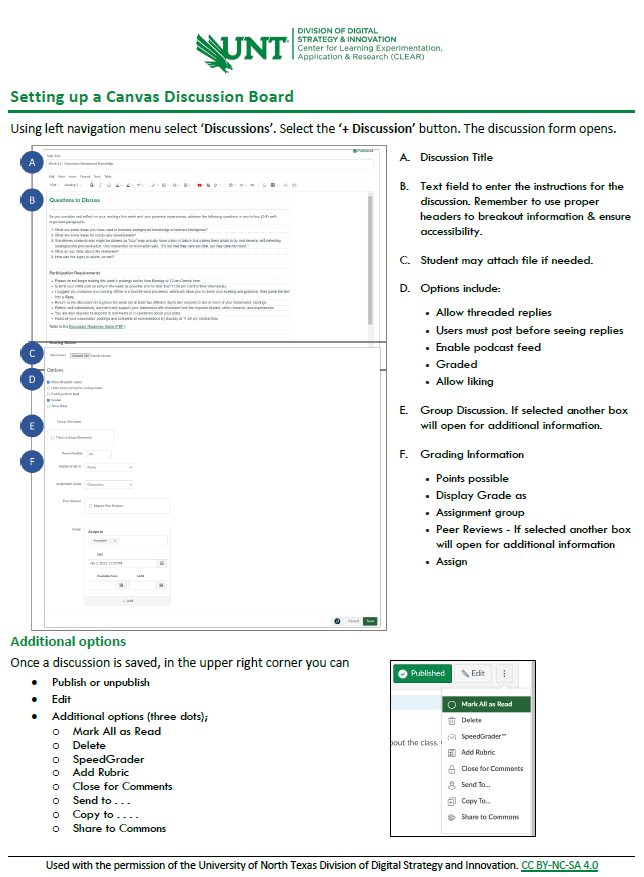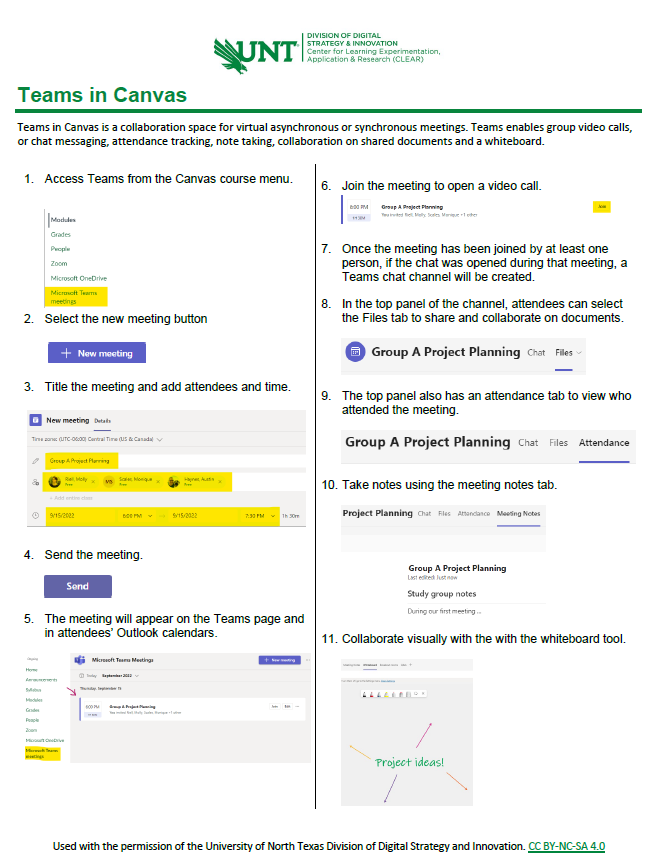- DSI CLEAR
- Teaching Resources
- Theory & Practice
- Methods for Continuous Improvement
- Using AI in the Higher Education Classroom
- Invisible Labor and Faculty Retention Since COVID-19
- Inclusive Discussions
- Inclusive Assessment
- Designing Assessments for Academic Integrity
- Inclusive Instructional Strategies
- Instructor Presence in the Online Classroom
- Tips for Providing Personalized Feedback to Students
- Course Design for Student Retention
- UNT's CLAW 3 Active Learning Classroom Instructional Guide
- UNT Faculty Teaching & Learning Resource Guide
- Growth Mindset in the Higher Education Classroom
- Course Outcomes & Objectives
- Multimedia Course Design for Student Engagement and Retention
- Level Up Learning With Portfolios
- Group Work in Higher Education: Benefits & Practices for Success
- Open Educational Resources & Copyright Essentials for Instructors
- Evaluating OER Resources
- Accessibility Online
- Copyright Guide
- Online Teaching
- UNT Syllabus Template
- Teaching Consultation Request
- Open Educational Resources & Copyright Essentials for Instructors
- Evaluating OER Resources
Inclusive Discussions

Class discussion can be a powerful tool for creating inclusive learning environments which improve student learning outcomes and retention. The recent literature identifies themes of student belonging, intersectionality, and inclusive online discussion practices. The following review examines each of these dimensions and provides evidence-based guidance on how to maximize the benefits of class discussion.
Historically, course content has been delivered through lecture. In contrast to collaborative, experiential, or discussion-based learning, traditional lecturing tends not to actively engage students (Lewis-Kipkulei et al., 2021). Classroom discussion, on the other hand, increases engagement, critical thinking, problem-solving skills, and promotes learning and retention of new information.
Discussion and Belonging
University students want to feel a sense of belonging to the community they have chosen (Smith et al., 2021). In addition to improving knowledge retention, class discussion can help increase students’ sense of belonging with the university learning community. A 2021 study by Batra & Klein found that class discussion was highly effective in creating a student-friendly learning environment and promoting interaction between students. A discussion-rich flipped classroom environment has also been found to encourage active student participation and autonomy, having a positive impact on academic performance (Cho et al., 2020).
Activities that invite interaction such as ice breakers, sharing personal information during introductions, and asking a student to explain how they found an answer to a problem can improve social integration and participation. Instructors can encourage such sharing by using immediacy behaviors such as appropriate self-disclosure, smiling, using correct pronouns, and asking students how their day is going (Sousa, 2021). By developing interpersonal relationships with students, instructors can positively influence learning outcomes and levels of engagement (Faulker et al., 2020).
Discussion and Intersectionality
Inclusive teaching strategies increase access to learning for students with marginalized identities such as race, class, nationality, ability, and gender (Faulkner et al., 2020). In addition to helping students find a sense of belonging in the classroom, discussion can also help underrepresented and marginalized students feel heard. Research suggests that campus environments that encourage discussion about culture are associated with a greater sense of belonging and persistence towards degree completion (Glass et al., 2022).
Classroom dialogue lends itself to discussion about challenging topics and can create space for difficult conversations. Multiple factors contribute to the dynamics of managing difficult conversations, including the race and gender of students and faculty, differences in lived experiences, and fear of exposing biases (McGowan et al., 2021). For instance, silence during difficult discussions may be utilized in different ways by students based upon the identities they hold (McGowan et al., 2021). If a discussion takes a heated turn and you find yourself in the middle of a microaggression or “hot moment,” the strategies shared on Georgia Tech’s Center for Teaching and Learning may be helpful. There is no one-size fits all approach to creating and maintaining an inclusive learning environment. The best path forward is to “continually interrogate our own practices toward more inclusive spaces for all of our students” (Mehta and Aguilera, 2020, p. 117).
Discussion in Online Spaces
Discussions online can be delivered synchronously or asynchronously. Whereas synchronous online discussions may take place over web conferencing software such as Zoom or Microsoft Teams, asynchronous discussions typically happen on discussion boards such as in Canvas. Tools such as clickers, web 2.0 technology, and gamification can also increase student participation (Hutain & Michinov, 2022).
Asynchronous online discussions can be easier to navigate for students with disabilities (Darby, 2020; Dahlstrom-Hakki, et al., 2020; Jamili & Krish, 2021; Sousa, 2021). They also allow for flexible submission, which increases access to learning. A comparative study of online graduate level programs at two Canadian universities, one delivered synchronously and one asynchronously, found that both online and in person discussion were effective in engaging students in deep learning (McDavid & Shepherd, 2021).
Suggested practices for designing and facilitating inclusive online discussions are offered below:
- Decide how much you are going to participate in the discussion forums to make sure it stays civil (Darby, 2020).
- Share and make oneself vulnerable in online discussion spaces (Sousa, 2021).
- Encourage organic conversation that reflects how students speak and relate outside of the classroom. Invite the use of gifs, emojis, memes, video clips, and images (Darby, 2020).
- Design questions with enough ambiguity to spur discussion (Darby, 2020).
- Write prompts that seek to achieve greater understanding rather than finite answers or solutions (Sousa, 2021).
- Find ways to connect course content to students’ lives and experiences (Peralta Equity Rubric, 2020).
- Use grading windows instead of grading deadlines (Mehta & Aguilera, 2020).
- Set guidelines such as a post and reply each week (Darby, 2020).
- Use settings that allow students to edit responses (Meyers et al., 2019).
- Clearly communicate how often you expect students to post and how much content is required. Provide a rubric or checklist for discussion post responses (Addy, et al., 2021).
- Involve students in the design of the rubric, checklist, or guidelines by which discussion participation will be evaluated (Mehta & Aguilera, 2020; Sousa, 2021).
Discussion can foster a sense of belonging, encourage critical thinking, and improve student learning outcomes in both in-person and online learning environments. The benefits of discussion in higher education classrooms are positively correlated with degree completion. DSI CLEAR’s faculty development team invites you to try these evidence-based practices and let us know how to they work in your UNT classes.
References
Addy, T.M., Dube, D., Mitchell, K.A., & SoRelle, M. (2021). What Inclusive Instructors Do: Principles and Practices for Excellence in College Teaching, Stylus Publishing.
Batra, M. M., & Klein, A. (2020). Effective pedagogy for small undergraduate classes. Journal of Education for Business, 96(3), 176-186. https://doi.org/10.1080/08832323.2020.1770160
Cho, M. H., Park, S. W., & Lee, S. E. (2020). Student characteristics and learning and teaching factors predicting affective and motivational outcomes in flipped college classrooms. Studies in Higher Education, 46(3), 509–522. https://doi.org/10.1080/03075079.2019.1643303
Dahlstrom-Hakki, I., Alstad, Z., & Banerjee, M. (2020). Comparing synchronous and asynchronous online discussions for students with disabilities: The impact of social presence. Computers & Education, 150(103842). https://doi.org/10.1016/j.compedu.2020.103842
Darby, F. (2020, Aug 24). The secret weapon of good online teaching: Discussion forums. The Chronicle of Higher Education.
Faulkner, S. L., Watson, W. K., Pollino, M. A., & Shetterly, J. R. (2020). “Treat me like a person, rather than another number”: university student perceptions of inclusive classroom practices. Communication Education, 70(1), 92–111. https://doi.org/10.1080/03634523.2020.1812680
Glass, C. R., Heng, T. T., & Hou, M. (2022). Intersections of identity and status in international students’ perceptions of culturally engaging campus environments. International Journal of Intercultural Relations, 89, 19-29. https://doi.org/10.1016/j.ijintrel.2022.05.003
Handling “Hot Moments” in the Classroom. (n.d.) Center for Teaching and Learning. Georgia Tech. https://ctl.gatech.edu/resources/best-practices/dealing-with-the-unexpected/Hot-Moments
Hutain, J., & Michinov, N. (2022). Improving student engagement during in-person classes by using functionalities of a digital learning environment. Computers & Education, 183, 104496. https://doi.org/10.1016/j.compedu.2022.104496
Jamali, M., & Krish, P. (2021). Fostering 21st century skills using an online discussion forum in an English for specific purposes. Malaysian Journal of Learning and Instruction, 18(1), 219-240. https://doi.org/10.32890/mjli2021.18.1.9
Lewis-Kipkulei, P., Singleton, J., Small Singleton, T., & Davis, K. (2021). Increasing student engagement via a combined roundtable discussion and flipped classroom curriculum model in an OT and special education classroom. Cogent Education, 8(1). https://doi.org/10.1080/2331186x.2021.1911284
McDavid, J. C., & Shepherd, R. (2021). Offering graduate evaluation degrees online: Comparing student engagement in two Canadian programs. Canadian Journal of Program Evaluation, 35(3). https://doi.org/10.3138/cjpe.69751
McGowan, B. L., Jones, C. T., Boyce, A. S., & Watkins, S. E. (2021). Black faculty facilitating difficult dialogues in the college classroom: A cross-disciplinary response to racism and racial violence. The Urban Review, 53(5), 881-903. https://doi.org/10.1007/s11256-021-00598-y
Mehta, R. & Aguilera, E. (2020). A critical approach to humanizing pedagogies in online teaching and learning. The International Journal of Information and Learning Technology, 37(3), 109-120.
Meyers, S., Rowell, K., Wells, M., & Smith, B.C., (2019). Teacher empathy: A model of empathy for teaching and student success. College Teaching, 67(3), 160-168.
Peralta Community College District. (2020). Peralta Online Equity Rubric, version 3.0 [Creative Commons license: BY-SA]. https://www.peralta.edu/distance-education/online-equity-rubric
Smith, S., Pickford, R., Edwards, L., Priestley, J., Sellers, R., & Sinclair, G. (2021). Building a sense of belonging in students: Using a participatory approach with staff to share academic practice. Journal of Perspectives in Applied Academic Practice, 9(1), 44-53. https://doi.org/10.14297/jpaap.v9i1.448
Sousa, A. (2021). Dialogue in online learning spaces: How transitioning to online learning during a pandemic impacts critical classroom dialogue and inclusivity. Journal of Teaching and Learning with Technology, 10(1). https://doi.org/10.14434/jotlt.v10i1.31383


